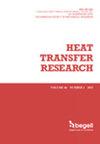An investigation over the influence of a radiant thermal mat’s dimensions on its local and average convective and radiative heat transfer characteristics
IF 1.6
4区 工程技术
Q3 THERMODYNAMICS
引用次数: 0
Abstract
For living spaces, radiant thermal mats are seen to be a good substitute for traditional heating systems. These devices, which are often powered by electricity, are installed on the floors, walls, and ceilings of rooms. The heat generated by the mat's absolute temperature causes direct and focused heating. The natural convection heat transfer properties of radiant heating and cooling systems have been well studied, while the properties of radiant mats placed on surfaces have received relatively less attention. Mats of square and rectangular dimensions (axb=0.5 m x 0.5 m, 1 m x 1 m, 1.2 m x 1.2 m, 1.4 m x 1.4 m, 1 m x 1.2 m, 1 m x 1.4 m, and 1 m x 1.6 m) are installed on the walls of an enclosure with floor dimensions (LxL= 4 m x 4 m) and a height of H= 3 m in order to address this gap in the literature. Average convective, radiative, and overall heat transfer characteristics—which are important for building energy simulation programs—are found and correlated for different mat dimensions using the surface-to-surface (S2S) radiation model and the k-ε RNG turbulence model in the numerical program, with error ranges of ±5%, ±5%, and ±15%, respectively.研究辐射热垫的尺寸对其局部和平均对流及辐射传热特性的影响
在居住空间,辐射热垫被认为是传统供暖系统的良好替代品。这些设备通常由电力驱动,安装在房间的地板、墙壁和天花板上。热垫的绝对温度产生的热量可直接集中加热。人们对辐射供暖和制冷系统的自然对流传热特性进行了深入研究,而对表面辐射垫的特性关注相对较少。为了解决文献中的这一空白,我们在一个地面尺寸(LxL= 4 m x 4 m)和高度 H= 3 m 的围墙墙壁上安装了正方形和长方形(axb=0.5 m x 0.5 m、1 m x 1 m、1.2 m x 1.2 m、1.4 m x 1.4 m、1 m x 1.2 m、1 m x 1.4 m 和 1 m x 1.6 m)的辐射垫。利用数值程序中的面到面(S2S)辐射模型和 k-ε RNG 湍流模型,找到了不同垫层尺寸下的平均对流、辐射和整体传热特性(这些特性对建筑能耗模拟程序非常重要),并将其相关联,误差范围分别为 ±5%、±5% 和 ±15%。
本文章由计算机程序翻译,如有差异,请以英文原文为准。
求助全文
约1分钟内获得全文
求助全文
来源期刊

Heat Transfer Research
工程技术-热力学
CiteScore
3.10
自引率
23.50%
发文量
102
审稿时长
13.2 months
期刊介绍:
Heat Transfer Research (ISSN1064-2285) presents archived theoretical, applied, and experimental papers selected globally. Selected papers from technical conference proceedings and academic laboratory reports are also published. Papers are selected and reviewed by a group of expert associate editors, guided by a distinguished advisory board, and represent the best of current work in the field. Heat Transfer Research is published under an exclusive license to Begell House, Inc., in full compliance with the International Copyright Convention. Subjects covered in Heat Transfer Research encompass the entire field of heat transfer and relevant areas of fluid dynamics, including conduction, convection and radiation, phase change phenomena including boiling and solidification, heat exchanger design and testing, heat transfer in nuclear reactors, mass transfer, geothermal heat recovery, multi-scale heat transfer, heat and mass transfer in alternative energy systems, and thermophysical properties of materials.
 求助内容:
求助内容: 应助结果提醒方式:
应助结果提醒方式:


